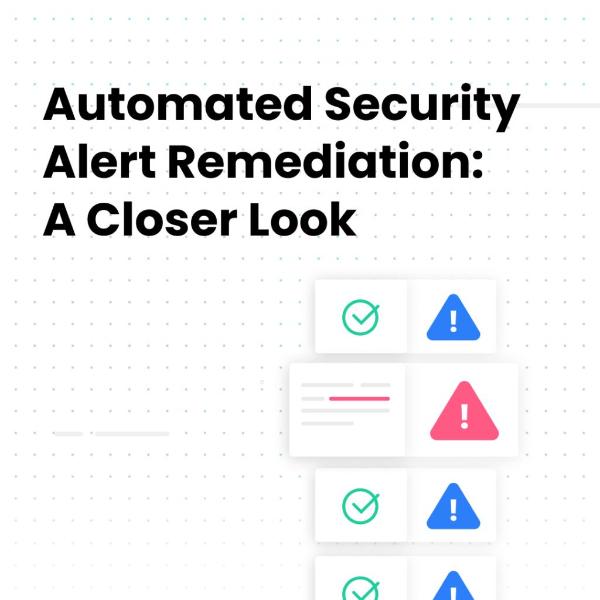Automated Security Alert Remediation: A Closer Look
In cloud-native organizations and software as a service (SaaS) businesses, cloud security automation is becoming a must-have feature. You can’t stay ahead of threats across several levels of your cloud environment using manual procedures alone, and you can’t rely exclusively on cloud providers’ security technology, which doesn’t operate across different clouds and lacks advanced automation features. Managing these infrastructures and apps in multi-cloud settings becomes increasingly difficult and compounds the operational issues that you face today. Automation is the way to go if you want to stay ahead of the game and meet the expectations of your customers.
Security alert remediation, a self-healing workflow that triggers and responds to alerts or events by taking actions that can prevent or fix the problem, is one of the pillars of security automation. It strives to ensure that security concerns in the cloud are dealt with quickly and effectively. Continue reading to learn about the fundamentals of automated security alert remediation, why it matters and some of the most important use cases for cloud-native and SaaS enterprises.
What Is Automated Security Alert Remediation and Why Does It Matter?
As more companies adopt cloud technology, managing and monitoring cloud security becomes increasingly crucial. They are continually using alerts defined within the cloud network perimeter to have total visibility into the environment and the operations of the security team. They’re even implementing technologies like XDR, CASB, SASE, cloud firewalls and DLP, which, when combined, can quickly generate an overwhelming and discontinuous number of alerts for security teams, making threat containment and analysis incredibly difficult and even counterproductive.
When it comes to security alerts, one of the biggest challenges faced by the typical organization is the sheer number of them. An alert regarding a potential threat or vulnerability is simple to create. However, it’s a lot more difficult to figure out which alerts need to be addressed right away, which ones can be dealt with later and which ones are false positives. Automation helps save teams from security alert fatigue. Your engineers will know which alerts are critical when you manage them automatically, since they can be categorized by which systems they affect, their priority level and other parameters.
Automated remediation of security alerts rescues you from the massive volume of alerts by automatically classifying alerts into the appropriate categories. You can set your cloud security systems to generate different types of alerts based on the severity of a given threat or the importance of affected resources to your operations. Furthermore, automatic security alert remediation relieves operations teams of the strain of responding to a high number of alerts and empowers users to self-remediate vulnerabilities. You’ll end up with far fewer security alerts in your queue if automation can fix configuration errors for you.
Automated Remediation Workflows
To properly implement automatic security alert remediation, you must choose the remediation workflow that works best for your organization. Alert management works with workflows that are scripted to match a certain rule to identify possible vulnerabilities and execute resolution tasks. With automation, workflows are automatically triggered by following asset rules and constantly inspecting the remediation activity logs to execute remediation.
To improve mean time to response and remediation, organizations create automated remediation workflows. For example, remediation alert playbooks aid in investigating events, blocking IP addresses or adding an IOC on a cloud firewall. There are also interactive playbooks that can help remediate issues like a DLP incident on a SaaS platform while also educating the user via dynamic interactions using the company’s communication tools.
The typical alert remediation workflow consists of multiple steps. It begins with the creation of a new asset policy, followed by the selection of a remediation action rule and concludes with the continued observation of the automatically quarantined rules. By inspecting the remediation activity logs, your security team can keep track of the automated activities that are being conducted. Investing in a security alert remediation solution like Torq will provide you with customized remediation procedures and playbooks.
Some of the security alert remediation tasks that Torq implements include:
- Automatically managing block and allow lists,
- Suspending or unsuspending users and managing user privileges,
- Scanning, isolating and remediating endpoints,
- Orchestrating cloud-native components,
- Following up on critical issues.
When creating a cloud management platform with policy-driven automation features, auto-remediation is one of the numerous options available. When combined with other solutions, it can improve your company’s cloud governance.
Implementing Automated Remediation
As stated above, attempting to manage security across large-scale cloud environments manually is practically impossible due to the manpower that it requires as well as the challenge of consistently enforcing security policies. To ease the burden, automatic alert remediation optimizes the investigation of and response to security alerts, thereby enabling users to resolve some security issues themselves.

